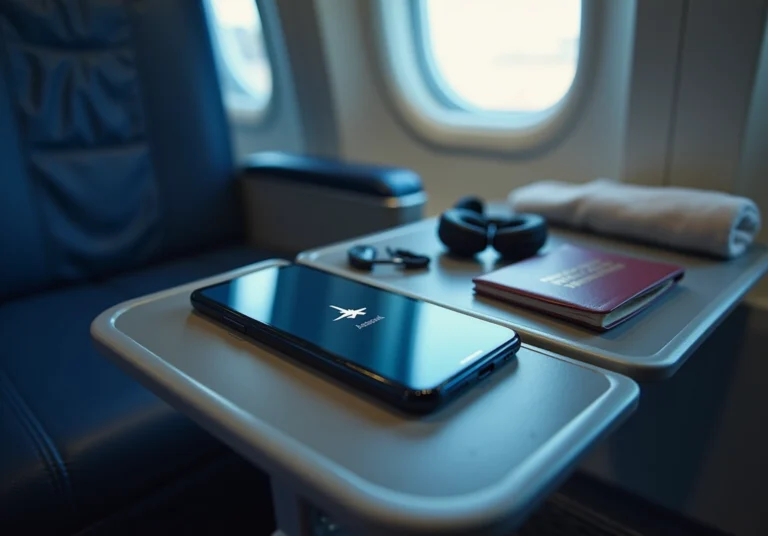Overview
Flight mode is a fantastic feature that disables all wireless communications on your devices, ensuring safety during flights. It helps prevent interference with aircraft systems and allows you to conserve battery life while minimizing distractions. Isn’t that great?
But wait, there’s more! This article dives into the various benefits of flight mode. It not only enhances your data privacy but also improves connectivity in low-signal areas. Plus, it enables you to access offline content—all while sticking to aviation regulations. So, next time you fly, you can feel good knowing you’re making the most out of your device while keeping everything safe and sound!
Key Highlights:
- Flight mode disables all wireless communications to prevent interference with aircraft systems during flights.
- It is important for safety, as active devices can disrupt critical aircraft communication.
- Enabling flight mode conserves battery life, reducing power consumption significantly during long trips.
- Flight mode minimises distractions from notifications, enhancing focus during meetings and events.
- Users can still access offline content like downloaded music and videos while in flight mode.
- Activating flight mode can improve connectivity in weak signal areas by allowing Wi-Fi use while cellular services are off.
- Flight mode enhances data privacy by disabling wireless communications, protecting against unauthorised access.
- It prevents electronic interference in sensitive environments, such as hospitals, by stopping device emissions.
- Users can manage connectivity by selectively enabling Wi-Fi or Bluetooth while keeping cellular services off.
Introduction
Understanding the intricacies of flight mode opens up a world of discoveries! It serves not just as a safety protocol but also as a handy tool for modern travelers like you. By disabling all wireless communications, this feature ensures compliance with aviation regulations and brings along some fantastic benefits, such as conserving your battery and minimizing distractions.
As you navigate the skies, you might wonder:
- How does flight mode actually enhance your security and data management?
- What practical applications make it indispensable for today’s tech-savvy travelers?
Exploring these facets reveals the true value of flight mode—it’s more than just a button to press; it’s a gateway to a smoother travel experience. Let’s dive in together and uncover what makes flight mode a must-have for your journeys!
Define Flight Mode: Purpose and Functionality
Many mobile gadgets include a handy feature known as flight setting, which raises the question of how does flight mode work. It disables all wireless communication functions like cellular data, Wi-Fi, and Bluetooth. The main reason for enabling airplane settings is to clarify how does flight mode work, which prevents your devices from sending or receiving signals that could interfere with aircraft communication systems during your travels. This is super important! Multiple active devices transmitting signals can pose a safety risk, potentially leading to missed critical information like traffic alerts or runway assignments.
But wait, there’s more! Along with its safety benefits, airplane setting offers some great features for travelers. It helps preserve battery life, which is especially crucial during long journeys, and minimizes distractions during meetings or events. By turning on airplane setting, you can still access offline content—think downloaded music, videos, or documents—while sticking to airline regulations.
A significant number of travelers use airplane settings during their flights, as they want to understand how does flight mode work in ensuring safety and enhancing their travel experience. Real-life examples illustrate how airplane settings have successfully prevented disruptions to aircraft communication systems, highlighting the importance of this feature. For instance, the FCC prohibits the use of cell phones while an aircraft is in the air due to concerns that signals could interfere with critical aircraft instruments. Aviation specialists emphasize that adhering to takeoff and landing regulations is essential for the safety of all passengers and crew. The Federal Aviation Administration (FAA) requires these guidelines to avoid any disturbances during flights. Ignoring these regulations can lead to distractions during important preflight safety announcements, which are crucial for ensuring passenger safety.
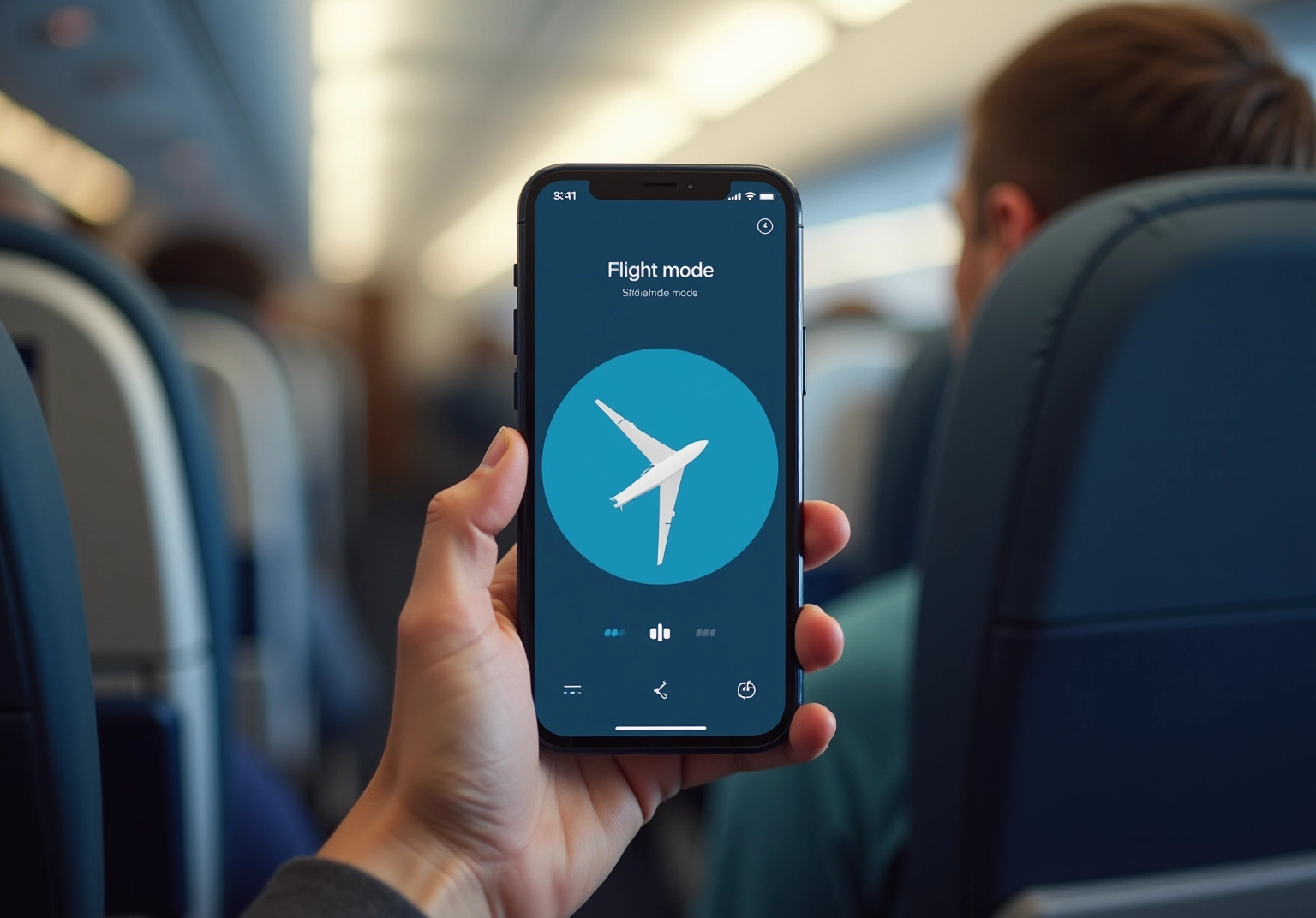
Explain How Flight Mode Works on Different Devices
Activating flight mode is a breeze on various devices like smartphones, tablets, and laptops, each with its own simple method to get you started:
-
Smartphones (iOS and Android): Most smartphones make it easy to find flight mode through the settings menu or quick access panel. For iOS users, just swipe down from the top-right corner to open the Control Center and tap the airplane icon. Android enthusiasts can swipe down from the top of the screen and select the airplane icon in the quick settings. Turning on flight mode not only keeps you compliant with FAA and FCC regulations but also helps reduce cellular signal emissions, minimizing your exposure to radiofrequency (RF) energy radiation.
-
Tablets: The process for tablets is quite similar to smartphones. Both iOS and Android tablets feature airplane options in their settings or quick access menus, making activation a snap. Plus, using flight mode on tablets can help conserve battery life—super handy during those long journeys!
-
Laptops: For Windows laptops, you can enable flight mode through the Action Center by clicking the notification icon in the taskbar and selecting the airplane symbol. Mac users don’t have a dedicated button for air travel, but you can easily turn off Wi-Fi and Bluetooth to achieve the same effect. Remember, even when flight mode is on, you can reactivate Bluetooth and Wi-Fi by tapping the relevant icons in the notification shade or Control Center, allowing for some connectivity while still following airline rules.
Engaging flight mode on all these devices turns off all wireless communications, ensuring you’re following airline regulations and enhancing safety during your travels. As travel writer Karen LeBlanc puts it, “Activating flight mode is a precautionary step that improves communication safety between the aircraft and air traffic control, ensuring smoother journeys and adherence to aviation safety regulations.” So, next time you’re ready to take off, you’ll know just how to stay connected—safely!
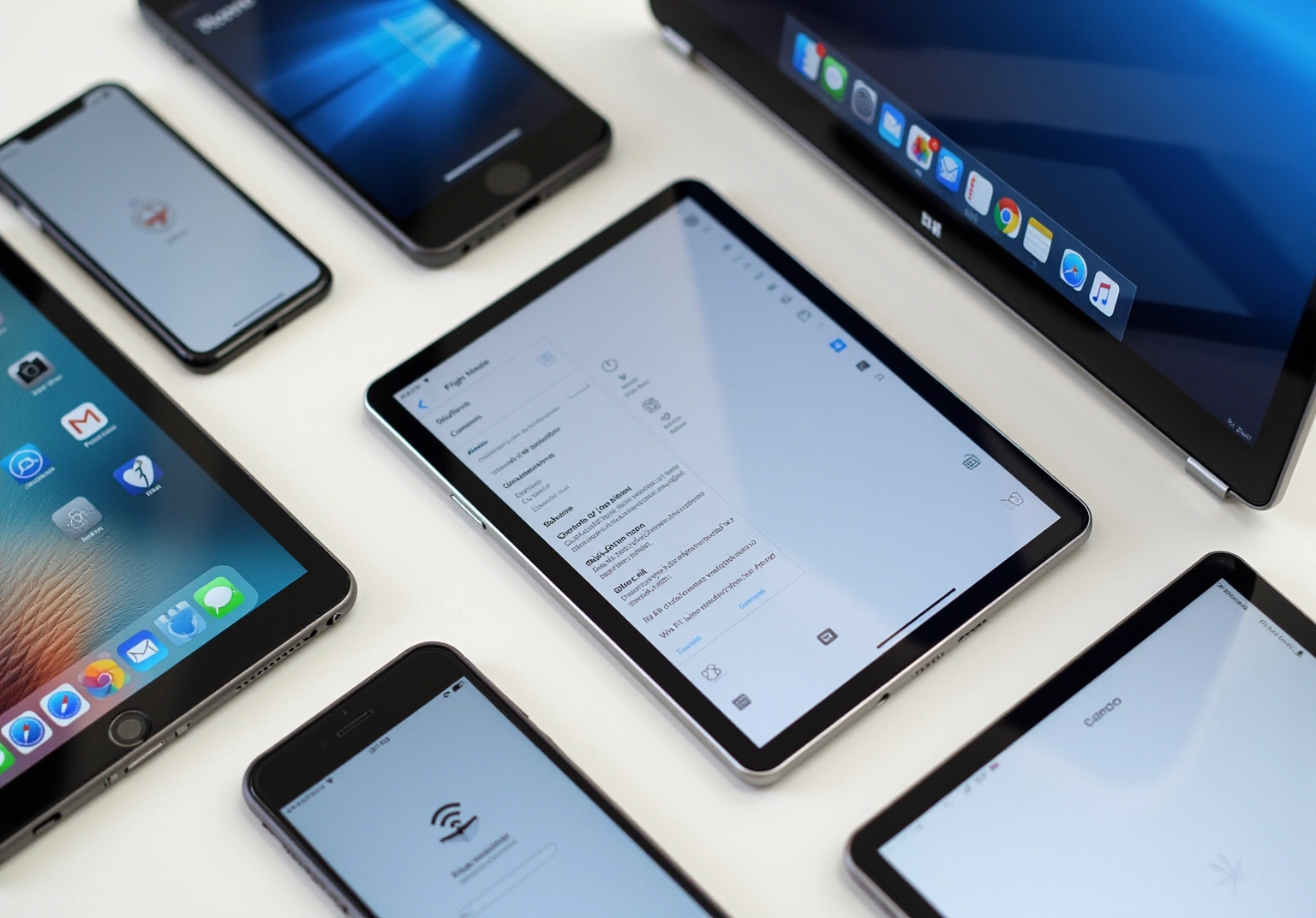
Discuss Practical Uses and Benefits of Flight Mode
Flight mode offers a variety of practical benefits that can truly enhance your experience, especially when you understand how does flight mode work.
First up, let’s talk about battery conservation. To understand how does flight mode work, it effectively turns off wireless communications to significantly stretch your battery life. This is especially handy during long trips or when charging options are scarce. It cuts down on power consumption from mobile networks, which can drain your battery by up to 10 percent over four hours if those wireless functions are on. I remember a 2016 test by Wirecutter that showed how browsing media in flight mode only caused the phone’s battery to drop by a few percent over four hours—pretty impressive, right?
Next, there’s minimizing distractions. When you switch on airplane mode during meetings, lectures, or even your personal downtime, it really helps reduce interruptions from notifications and calls. This way, you can keep your focus and engage more fully in whatever you’re doing. Many users enable airplane mode specifically to cut down on distractions, and I can see why—it’s a fantastic tool for boosting productivity!
Then we have offline access. Even while in airplane mode, you can still enjoy downloaded content like e-books, music, and videos. This makes it a perfect setting for entertainment during travel, allowing for a seamless experience without needing an internet connection. Just a heads up, though: GPS might be a bit slower and less accurate, which relates to how does flight mode work.
Lastly, let’s not forget about enhanced connectivity. In areas with weak cellular signals, activating airplane mode and then turning on Wi-Fi can actually improve your connection. This clever trick allows your devices to link to available networks more efficiently, especially since mobile units are often too high up to get reliable signals at cruising altitude. So, if you need to get online, this could be your ticket!
These advantages really demonstrate how does flight mode work as a handy resource for both travelers and everyday users, enhancing device functionality and enriching your overall experience. So next time you’re about to take off, remember these tips—they might just make your journey a little smoother!
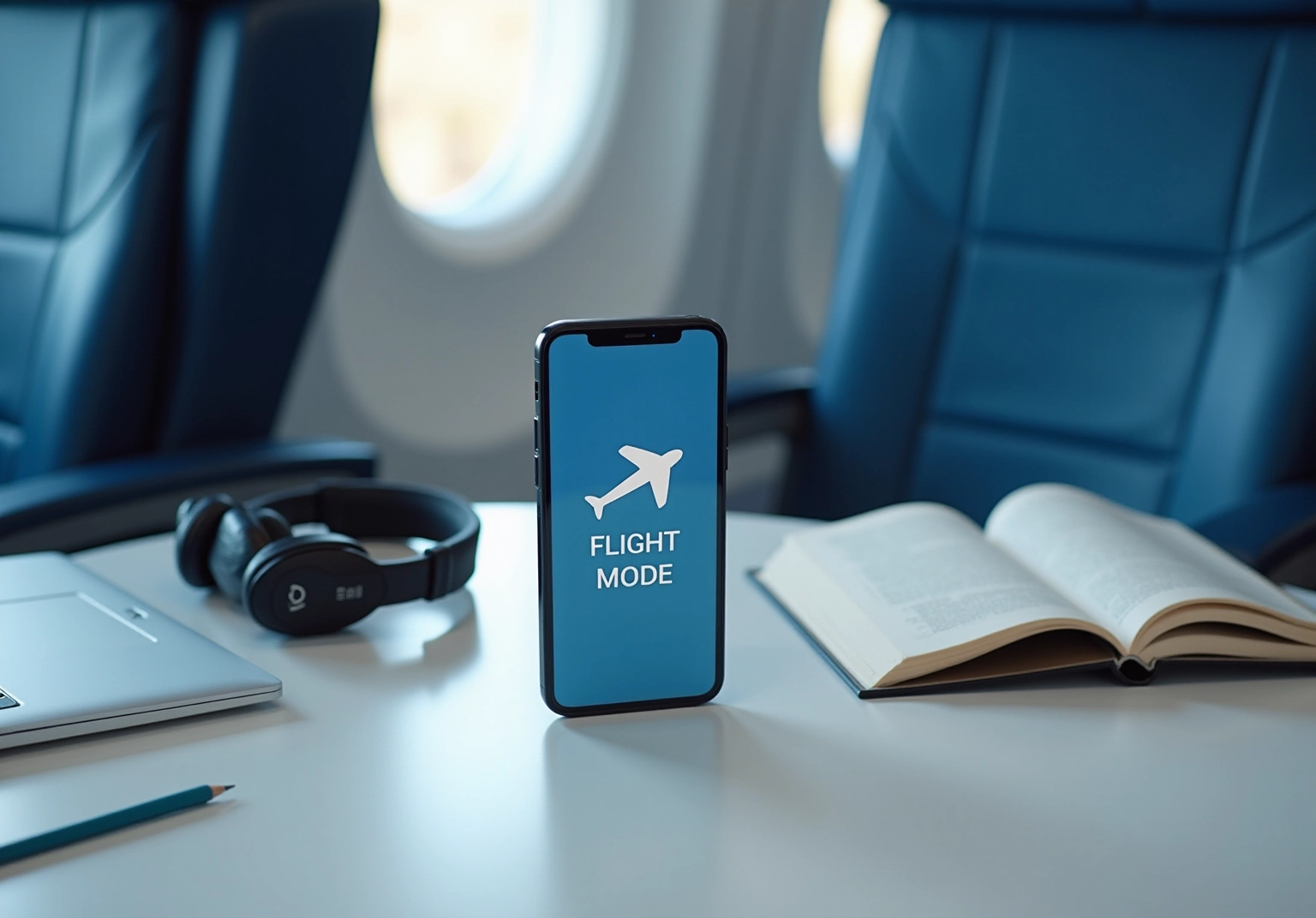
Analyze Security and Data Management in Flight Mode
Flight mode is a fantastic way to boost your security and manage your data, no matter where you are!
- Data Privacy: When you switch on flight mode, it disables all wireless communications. This means unauthorized access to your personal data is kept at bay. It’s especially handy when you find yourself in areas with public Wi-Fi or using sensitive apps, as it lowers the risk of breaches. Did you know that research shows how does flight mode work for 31% of participants who reported their organizations faced a breach? That really highlights how important it is to use airplane settings for your privacy!
- Protection from Interference: If you’re in places where electronic interference can be an issue—like hospitals or secure facilities—flight mode is your best friend. It ensures your devices don’t emit signals that could disrupt sensitive equipment. Following safety regulations is key to maintaining operational integrity in these environments!
- Managed Connectivity: You can choose to turn on Wi-Fi or Bluetooth while keeping cellular services off. This gives you more control over your connections and enhances security. It’s particularly useful in public areas where safeguarding your information is crucial. Research indicates that many users activate airplane settings mainly for privacy concerns, which leads to the question of how does flight mode work as a proactive measure against potential risks.
Real-life examples show just how effective airplane settings can be in protecting your information. For instance, when travelers connect to public Wi-Fi in airports or cafes, enabling airplane mode can shield their devices from unauthorized access while still allowing for in-flight Wi-Fi services. Cybersecurity experts stress that using airplane settings in these situations not only boosts personal safety but also fosters a culture of awareness about data management practices.
By grasping these points, you can use flight mode not just for compliance during flights but as a smart strategy to enhance your device’s security in everyday life!
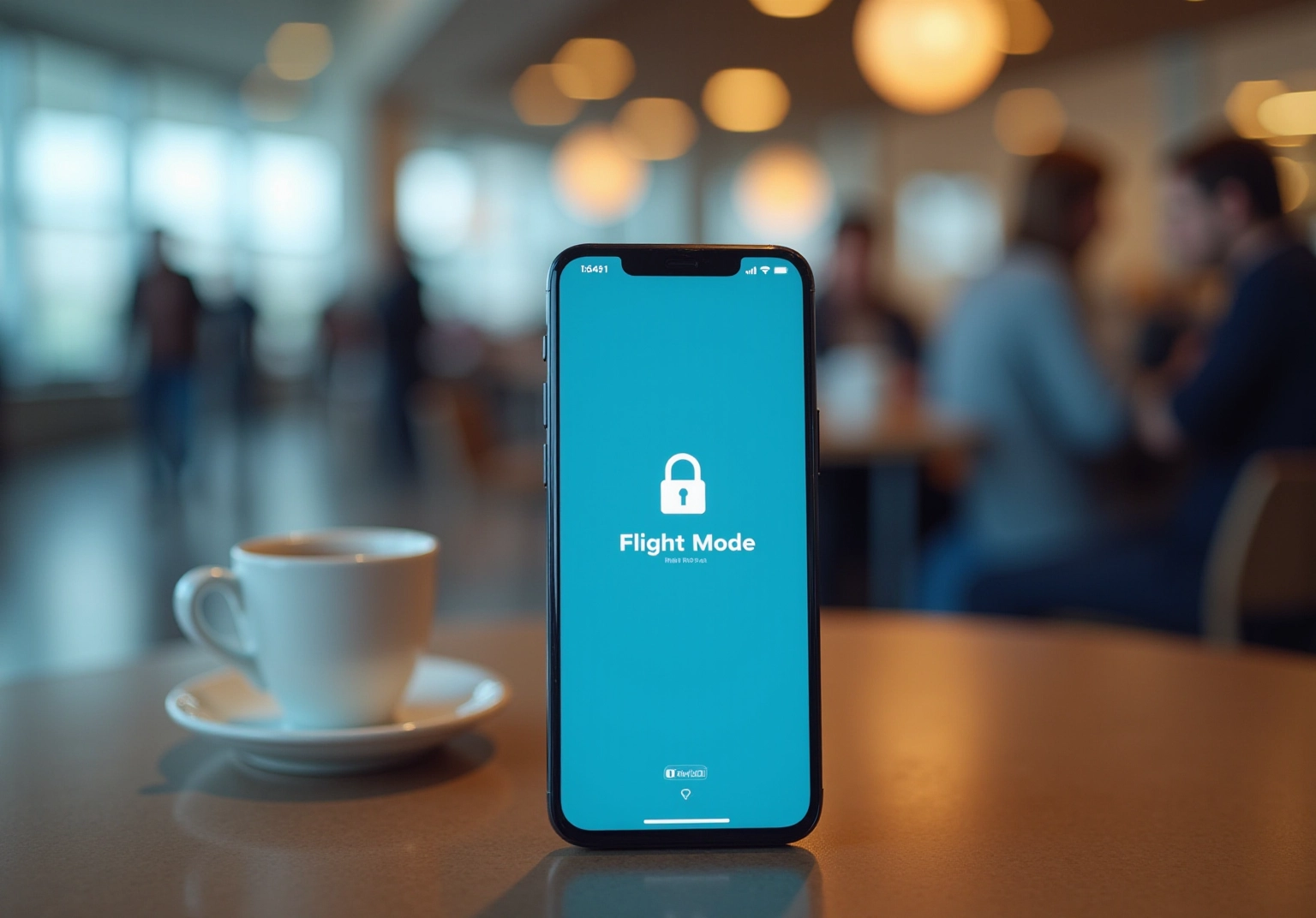
Conclusion
Enabling flight mode isn’t just a simple toggle on your devices; it plays a crucial role in ensuring safety and enhancing your travel experience. By disabling all wireless communications, flight mode prevents potential interference with aircraft systems. Plus, it offers practical benefits like conserving battery, reducing distractions, and improving data security!
This article highlights key aspects of flight mode, showcasing its functionality across various devices like smartphones, tablets, and laptops. It emphasizes how this feature not only complies with aviation regulations but also boosts your personal productivity and privacy. And guess what? The practical uses of flight mode extend beyond air travel, proving its value in everyday scenarios where managing connectivity and protecting your data are essential.
Ultimately, understanding how flight mode works can transform it from a mere travel necessity into a versatile tool for enhancing your device performance and safeguarding your personal information. Embracing this feature not only promotes compliance with safety regulations but also empowers you to take control of your digital environment. So, whether you’re a frequent traveler or just someone who enjoys using devices daily, making flight mode a part of your routine is an essential practice!
Frequently Asked Questions
What is flight mode and what is its purpose?
Flight mode is a feature on mobile devices that disables all wireless communication functions, including cellular data, Wi-Fi, and Bluetooth. Its primary purpose is to prevent devices from sending or receiving signals that could interfere with aircraft communication systems during flights.
Why is it important to enable flight mode during flights?
Enabling flight mode is important because multiple active devices transmitting signals can pose a safety risk, potentially leading to missed critical information like traffic alerts or runway assignments. It helps ensure the safety of all passengers and crew.
What benefits does flight mode offer to travelers?
Flight mode helps preserve battery life during long journeys and minimizes distractions during meetings or events. It allows users to access offline content, such as downloaded music, videos, or documents, while adhering to airline regulations.
Are there regulations regarding the use of mobile devices during flights?
Yes, the FCC prohibits the use of cell phones while an aircraft is in the air due to concerns about interference with critical aircraft instruments. The FAA requires adherence to takeoff and landing regulations to avoid disturbances during flights.
What are the consequences of ignoring flight mode regulations?
Ignoring flight mode regulations can lead to distractions during important preflight safety announcements, which are crucial for ensuring passenger safety. It can also pose a risk to the safety of passengers and crew.









